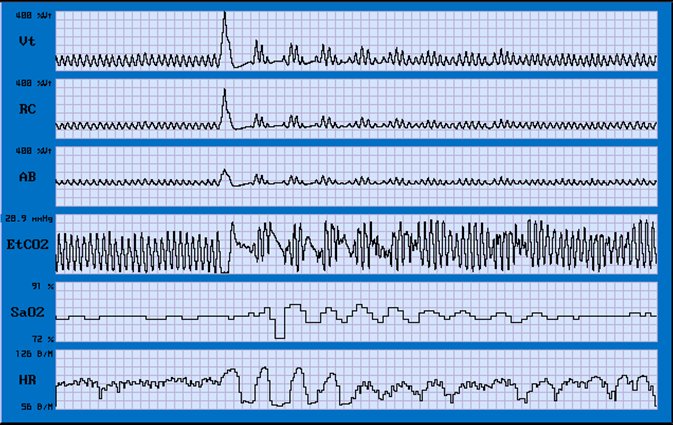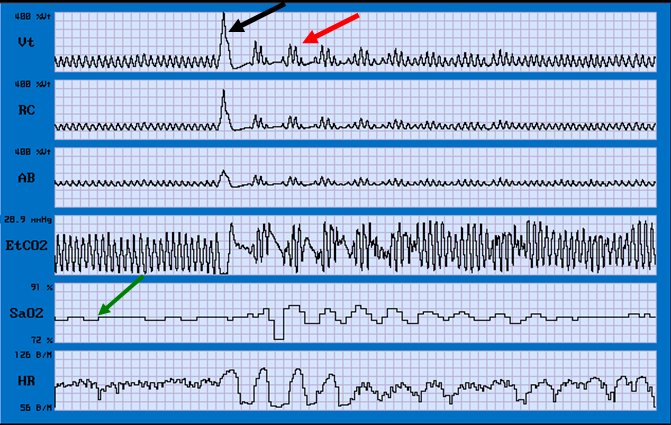Contributed by Malcolm Kohler, MD, and Konrad E. Bloch, MD, Sleep Unit, Pulmonary Division, University Hospital of Zurich, Switzerland
A 9 year old healthy boy (no history of respiratory disease) participated in a study during his summer holidays in the Swiss alps and consecutively underwent a nocturnal respiratory polygraphic recording (first night after arrival). Shown is a 4 minute fragment of the sleep study obtained at 2.15 am. What sleep disorder is suggested by the fragment? Legend: RC=ribcage; AB=abdomen; VT=ribcage+abdomen; EtCO2=end-tidal carbon dioxide tension; SaO2=arterial oxygen saturation; HR=heart rate
The fragment shows a time series of nocturnal inductive plethysmographic recordings obtained at a high altitude research station (Jungfrau-Joch, Switzerland, 3,450 m above sea level). Note the low SaO2 (approximately 80%) at the beginning of the tracing (green arrow). A short sequence of periodic breathing (red arrow), associated with pronounced fluctuations in SaO2 and HR, begins with a sigh as the initial disturbance (black arrow). The breathing pattern normalizes after only a few cycles of periodic breathing.
At high altitude hypobaric hypoxia increases ventilation and induces respiratory alkalosis. This attenuates hypoxemia but also destabilizes ventilation due to the hypocapnia that induces apnea. Consecutively periodic breathing characterized by crescendo-decrescendo ventilation with hyperpnea alternating with hypopnea/apnea may be observed. Periodic breathing also causes frequent arousals from sleep resulting in poor sleep quality, one of the manifestations of acute mountain sickness.
The findings of a recently published study showed that during acute high altitude exposure children experience a similar degree of hypoxemia and hyperventilation compared to adults but children have significantly less periodic breathing during sleep. The more stable control of ventilation at high altitude seen in children was related to a lower apnea threshold for CO2, a larger CO2 reserve and a shorter circulation time in children in comparison to adults.
References
- Berssenbrugge A, Dempsey J, Iber C, Skatrud J, Wilson P. Mechanisms of hypoxia-induced periodic breathing during sleep in humans. J Appl Physiol1983;343:507-526.
- Kohler M, Kriemler S, Wilhelm EM, Brunner-LaRocca H, Zehnder M, Bloch KE. Children at high altitude have less nocturnal periodic breathing than adults.Eur Respir J 2008;32:189-197.





